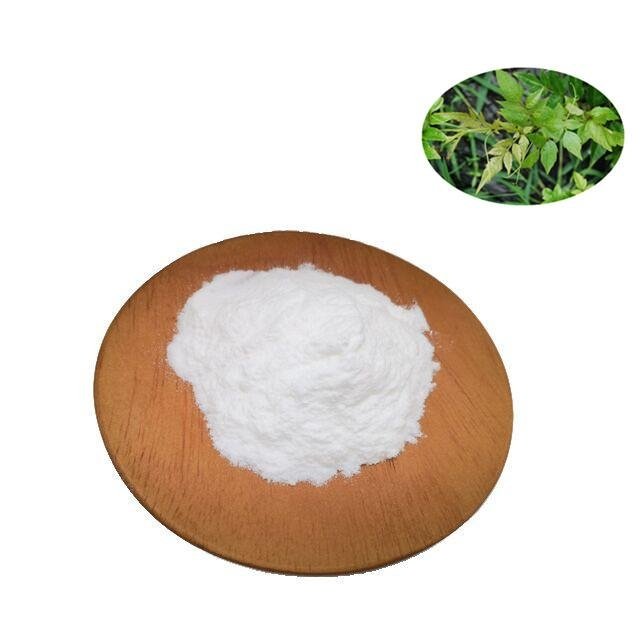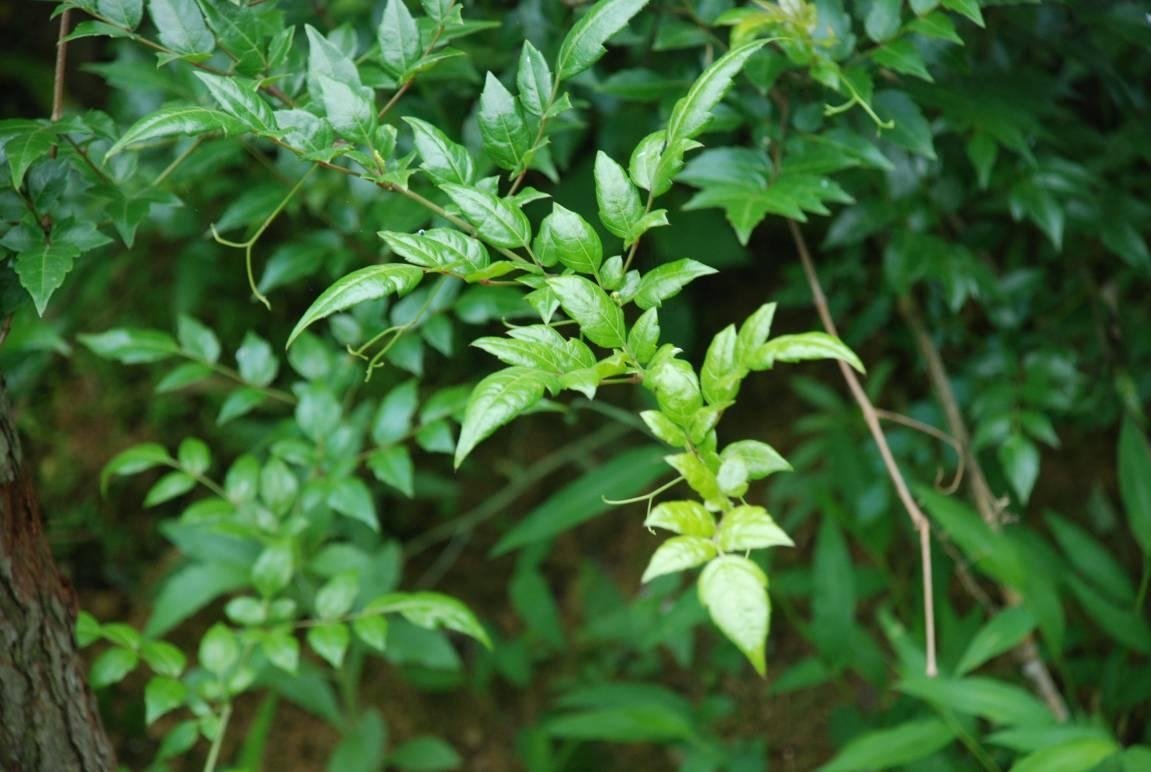
Vine tea extract dihydromyricetin
Source:Vine tea
Latin name:Ampelopsis grossedentata(Hand-Mazz)WT Wan
Extract part:Leaf
Specifications: 5%-98%
Active Ingredient :Dihydromyricetin
CAS:327-97-9
Test Method:HPLC
Appearance: Fine white powder
| Vine tea extract |
||||
| Active Ingredients |
Specs |
Test Method |
Appearance |
Solubility |
| Dihydromyricetin |
98% |
HPLC |
Off white powder |
Soluble in water |
| Myricetin |
80%-98% |
HPLC |
Greenish yellow powder |
Soluble in ethanol |
Vine tea extract introduction:
The vine tea tree is a rare and typical tea tree, known as dragon boat tea, dragon whisker tea, growing in hillside shrubs or valley woodland of 1300-1950 meters, has been regarded as the legendary health tea. Studies have shown that vine tea has the effect of reducing inflammation, relieving cough, and also has a strong inhibitory effect on common bacteria in food.
Dihydromyricetin introduction
Dihydromyricetin (DHM) is a natural extract of vine tea. For centuries, DHM has been used in traditional Chinese medicine to treat hangovers and relieve alcohol.
Flavonoids such as staphylococcus and dihydromyricetin in vine tea are the main active components, and their MIC and MBC are basically the same as berberine, and the free radical scavenging activity is between 73.3 and 91.5%. It can also reduce oxidative damage in the body, delay aging, and reduce liver deformation and tissue necrosis.
How does Dihydromyricetin powder work?
There is no other product more proven to reduce hangover symptoms except Dihydromyricetin powder. It has been studied extensively on mice and interacts with alcohol in a very unique way.
First, Dihydromyricetin powder is able to actually dampen the effect alcohol has on your brain. It does this by binding to GABA receptors. GABA is a neurotransmitter effected by alcohol. After alcohol enters your blood stream and reaches your brain it binds to GABA receptors and enhances the effect you get from the GABA neurotransmitter. This leads to your heart rate slowing, feelings of relaxation, and eventually drunkenness. Dihydromyricetin powder also binds to GABA receptors and softens the effect alcohol has on them. This lessens acute alcohol withdrawal the next day which reduces hangover symptoms.
Second, Dihydromyricetin powder enhances your livers ability to metabolize alcohol and alcohol’s toxic by product, acetaldehyde. When alcohol is metabolized in your liver it turns to acetaldehyde. Acetaldehyde is much more toxic than alcohol and can cause extreme nausea, headaches, and sensitivity to light. Dihydromyricetin powder helps your body remove acetaldehyde more quickly which decreases hangover symptoms the next day.

Dihydromyricetin Function
1.Dihydromyricetin has the best effect of anti-alcohol;
2.Vine tea extract can protect the liver and stomach;
3.Dihydromyricetin has the best effect of anti-hypertension;antitumor, antioxidation,anti-inflammation;
4.Vine tea extract has the best effect of antibiotic action;
5.Dihydromyricetin has the best effect of cardiovascular
protection and enhancing immunity.
Dihydromyricetin Application
1.Applied in food industry
2.Applied in health product, vine tea extract dihydromyricetin powder used as raw materials to enhance body immunity
3.Applied in pharmaceutical field, vine tea extract dihydromyricetin powder used as capsules or pills to treat respiratory tract infection and protect liver
Dihydromyricetin by HPLC
1.Reagent
1.1 Methanol (AR)
1.2 Double distilled water (HPLC)
1.3 Reference substance
1.4 Acetic Acid (HPLC)
2.Instrument
2.1 Electronic balance (1/100000)
2.2 Glass instrument: volumetric flask
2.3 0.45μm microfiltration membrane and Syringe filter
2.4 Ultrasonic cleaning instrument
2.5 HPLC
2.5.1 Agilent 1220 infusion pump
2.5.2 Agilent 1220 SPD-20A UV-VIS Detector
2.5.3 Agilent 1220 workstation
3. Chromatographic condition
3.1 Chromatographic column: LUNA ODS2 , 250mm×4.6mm, 5µ
3.2 Mobile phase: Methanol: Water: Acetic Acid =50:50:1 (v/v)
3.3 Flow rate: 1.0ml/min
3.4 Detection wavelength:292nm
3.5 Sample size: 20μl
3.6 Column temperature: room temperature
4 .Operate step
4.1 preparation of test sample solution
4.1.1 Precision weigh 1mg sample, put in the 10ml volumetric flask
4.1.2 Dissolved with 50% of Methanol , ultrasound 15min,cool to room temperature, constant volume with 50% of methanol, shake up, Filtered with 0.45μm microfiltration membrane, stand-by.
4.1.3 Preparation of standard solution
Precision weigh appropriate of Dihydromyricetin, make up the solution concentration of 0.1mg/ml with 50% of methanol.
4.2 Inject 5μl test sample solution and standard solution each to HPLC.
5.Calculate
Dihydromyricetin (%)=
A1 x C2 x V
R=-----------------x 100
A2 x M1
A1:total peak area of Dihydromyricetin
A2:peak area of standard substance
C2: concentration of standard substance (mg/ml)
M1: sample size (mg)
V: constant volume of sample
Dihydromyricetin working process
Raw Material (Vine tea)-----------Choose and wish and wipe off impurity----------Crushing-Ethanol (Food Grade)
extraction---------Concentrate---------- centrifugal------------on macroporous resin column----------Respectively elution with 20%, 40%, 60%,80% ethanol-----------fractional collections---------decolorizing----------Crystallization---------More time Crystallization------------Drying---------Mixing, Screening, Packaging------------Storage
References:
1.Seymour RB, Deanin RD, editors. History of polymeric composites. Utrecht, The Netherlands: VNU Science Press; 1987. pp. 223.
2.Nedelcev T, Krupa I, Csomorova K, Janigova I, Rychly J. Synthesis and characterization of the new silane-based antioxidant containing 2,6-di-tert-butylphenolic stabilizing moiety. Polym Adv Technol. 2007;18:157–64.
3.Pospíšil J. Exploitation of the current knowledge of antioxidant mechanisms for efficient polymer stabilization. Polym Adv Technol. 1992;3:443–55.
4.Bracco P, Brunella V, Zanetti M, Luda MP, Costa L. Stabilisation of ultra-high molecular weight polyethylene with vitamin E. Polym Degrad Stab. 2007;92:2155–62.
5.Al-Malaika S, Goodwin C, Issenhuth S, Burdick D. The antioxidant role of alpha-tocopherol in polymers II. Melt stabilising effect in polypropylene. Polym Degrad Stab. 1999;64:145–56.
6.Al-Malaika S, Issenhuth S. The antioxidant role of alpha-tocopherol in polymers III. Nature of transformation products during polyolefins extrusion. Polym Degrad Stab. 1999;65:143–51.
7.Al-Malaika S. Vitamin E: an effective biological antioxidant for polymer stabilisation. Polym Polym Compos. 2000;8:537–42.
8.Al-Malaika S, Issenhuth S. The antioxidant role of vitamin E in polymers. IV. Reaction products of DL-alpha-tocopherol with lead dioxide and with polyolefins. Polymer. 2001;42:2915–39.
9.Al-Malaika S, Issenhuth S, Burdick D. The antioxidant role of vitamin E in polymers V. Separation of stereoisomers and characterisation of other oxidation products of dl-alpha-tocopherol formed in polyolefins during melt processing. Polym Degrad Stab. 2001;73:491–503.
10.Towatari K, Yoshida K, Mori N, Shimizu K, Kondo R, Sakai K. Polyphenols from the heartwood of Cercidiphyllum japonicum and their effects on proliferation of mouse hair epithelial cells. Planta Med. 2002;68:995–8.
11.Zhang YS, Ning ZX, Yang SZ, Wu H. Antioxidation properties and mechanism of action of dihydromyricetin from Ampelopsis grossedentata. Yao Xue Xue Bao. 2003;38:241–4.
12.Matsumoto T, Tahara S. Ampelopsin, a major antifungal constituent from Salix sachalinensis, and its methyl ethers. Nippon Nogeik Kaishi. 2001;75:659–67.
13.Hayashi T, Tahara S, Ohaushi T. Genetically-controlled leaf traits in two chemotypes of Salix sachalinensis Fr. Schm (Salicaceae). Biochem Syst Ecol. 2005;33:27–38.
14.Semsarzadeh MA, Poursorkhabi V. Synthesis and kinetics of non-isothermal degradation of amide grafted high density polyethylene. Polym Degrad Stab. 2009;94:1860–6.
15.Bockhorn H, Hornung A, Hornung U. Mechanisms and kinetics of thermal decomposition of plastics from isothermal and dynamic measurements. J Anal Appl Pyrolysis. 1999;50:77–101.
16.Park JW, Oh SC, Lee HP, Kim HT, Yoo KO. A kinetic analysis of thermal degradation of polymers using a dynamic method. Polym Degrad Stab. 2000;67:535–40.
17.Ceamanos J, Mastral JF, Millera A, Aldea ME. Kinetics of pyrolysis of high density polyethylene. Comparison of isothermal and dynamic experiments. J Anal Appl Pyrolysis. 2002;65:93–110.
18.Gao Z, Amasaki I, Nakada M. A thermogravimetric study on thermal degradation of polyethylene. J Anal Appl Pyrolysis. 2003;67:1–9.
19.Kim S, Jang E-S, Shin D-H, Lee K-H. Using peak properties of a DTG curve to estimate the kinetic parameters of the pyrolysis reaction: application to high density polyethylene. Polym Degrad Stab. 2004;85:799–805.
20.Sinfrônio FSM, Santos JCO, Pereira LG, Souza AG, Conceição MM, Fernandes VJ Jr, et al. Kinetic of thermal degradation of low-density and high-density polyethylene by non-isothermal thermogravimetry. J Therm Anal Calorim. 2005;79:393–9.
21.Koleva D, Atanassov A. Non-isothermal kinetics of degradation of ultra-high molecular mass polyethene composite materials: part I. Composite materials with fiber monocrystals. J Therm Anal Calorim. 2008;91:213–8.
22.Xin ML, Ma YJ, Xu K, Chen MC. Structure–activity relationship for dihydromyricetin as a new natural antioxidant in polymer. J Appl Polym Sci. 2012;. doi:10.1002/APP.38010.
23.Sheshkali HRZ, Assempour H, Nazockdast H. Parameters affecting the grafting reaction and side reactions involved in the free radical melt grafting of maleic anhydride onto high density polyethylene. J Appl Polym Sci. 2007;105:1869–81.
24.Bigger SW, Delatycki O. A new approach to the measurement of polymer photooxidation. J Polym Sci Polym Chem. 1987;25:3311–23.
25.Chen ZY, Chen PT, Ho KY, Fung KP, Wang J. Antioxidant activity of natural flavonoids is governed by number and location of their aromatic hydroxyl groups. Chem Phys Lipids. 1996;79:157–63.
26.Foti M, Piattelli M, Baratta MT, Ruberto G. Flavonoids, coumarins, and cinnamic acids as antioxidants in a micellar system. Structure–activity relationship. J Agric Food Chem. 1996;44:497–501.
27.Chen YH, Wang Q. Thermal oxidative degradation kinetics of flame-retarded polypropylene with intumescent flame-retardant master batches in situ prepared in twin-screw extruder. Polym Degrad Stab. 2007;92:280–91.
28.Chrissafis K, Paraskevopoulos KM, Stavrev SY, Docoslis A, Vassiliou A, Bikiaris DN. Characterization and thermal degradation mechanism of isotactic polypropylene/carbon black nanocomposites. Thermochim Acta. 2007;465(1–2):6–17.
29.Jankovic B, Adnaevic B, Mentus S. The kinetic study of temperature-programmed reduction of nickel oxide in hydrogen atmosphere. Chem Eng Sci. 2008;63:567–75.
30.Kissinger HE. Reaction kinetics on differential thermal analysis. Anal Chem. 1957;29:1702–6.
31.Ozawa T. Kinetics in differential thermal analysis. Bull Chem Soc Jpn. 1965;38:1881–6.
32.Flynn JH, Wall LA. General treatment of the thermogravimetry of polymers. J Res Nat Bur Stand A. 1966;
70:487–523.
33.Doyle CD. Estimating isothermal life from thermogravimetric data. J Appl Polym Sci. 1962;6:639–42.